
Viet Cong and PAVN battle tactics
Encyclopedia
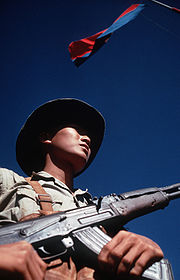
Guerrilla warfare
Guerrilla warfare is a form of irregular warfare and refers to conflicts in which a small group of combatants including, but not limited to, armed civilians use military tactics, such as ambushes, sabotage, raids, the element of surprise, and extraordinary mobility to harass a larger and...
and conventional warfare
Conventional warfare
Conventional warfare is a form of warfare conducted byusing conventional military weapons and battlefield tactics between two or more states in open confrontation. The forces on each side are well-defined, and fight using weapons that primarily target the opposing army...
battle tactics used by the Main Force of the People's Liberation Armed Forces (known as the Viet Cong or VC in the West) and the NVA (People's Army-Vietnam) to defeat their American
United States armed forces
The United States Armed Forces are the military forces of the United States. They consist of the Army, Navy, Marine Corps, Air Force, and Coast Guard.The United States has a strong tradition of civilian control of the military...
and South Vietnamese (GVN/ARVN
Army of the Republic of Vietnam
The Army of the Republic of Viet Nam , sometimes parsimoniously referred to as the South Vietnamese Army , was the land-based military forces of the Republic of Vietnam , which existed from October 26, 1955 until the fall of Saigon on April 30, 1975...
) opponents during the Second Indochina War (Vietnam War
Vietnam War
The Vietnam War was a Cold War-era military conflict that occurred in Vietnam, Laos, and Cambodia from 1 November 1955 to the fall of Saigon on 30 April 1975. This war followed the First Indochina War and was fought between North Vietnam, supported by its communist allies, and the government of...
).
For related articles on strategy/organization and logistics see:
- Viet Cong and PAVN strategy, organization and structureViet Cong and PAVN strategy, organization and structureDuring the Second Indochina War, better known as the Vietnam War, a distinctive land warfare strategy and organization was used by the Main Force of the People's Liberation Armed Forces and the NVA to defeat their American and South Vietnamese opponents...
- Viet Cong and PAVN logistics and equipmentViet Cong and PAVN logistics and equipmentThe Viet Cong and the People's Army of Vietnam used well-organized logistics methods to supply and equip their fighting forces...
The National Liberation Front (NLF) in this article, identifies an umbrella of front groups set up by the North Vietnamese government to conduct the insurgency in South Vietnam
Vietnam
Vietnam – sometimes spelled Viet Nam , officially the Socialist Republic of Vietnam – is the easternmost country on the Indochina Peninsula in Southeast Asia. It is bordered by China to the north, Laos to the northwest, Cambodia to the southwest, and the South China Sea –...
. The NLF was also affiliated with several independent groups and sympathizers. The armed wing of the NLF was regional and local guerrillas, and the People's Liberation Armed Forces (PLAF). The PLAF was the "Main Force" - the Chu Luc or full-time soldiers of the NLF's military muscle. Many histories lump both the NLF and the armed wing under the term "Viet Cong" in common usage. Both were tightly interwoven and were in turn controlled by the North. Others consider the Viet Cong to primarily refer to the armed elements. The term PAVN
Vietnam People's Army
The Vietnam People's Army is the armed forces of Vietnam. The VPA includes: the Vietnamese People's Ground Forces , the Vietnam People's Navy , the Vietnam People's Air Force, and the Vietnam Marine Police.During the French Indochina War , the VPA was often referred to as the Việt...
(People's Army of Vietnam) identifies regular troops of the North Vietnamese Army (NVA). Collectively, both forces - the southern armed wing and the regulars from the north were part of PAVN, and are treated as such in official communist histories of the war.
Certain terms such as "NLF" and "VC" or "NVA" and PAVN" are used interchangeably, and they, along with others used herein such as "Chicom", "Liberation Army", "regime" etc. have no pejorative or partisan intent or meaning. They are incorporated here due to their widespread popular usage by both South Vietnamese and American military personnel and civilians, and common usage in standard histories of the Vietnam War.
Seizing the initiative: metering losses and controlling tempo
The NVA and VC conducted numerous attacks and defensive manoeuvres, generally having the advantage of choosing the time and place for such operations. Such initiative was sometimes blunted by ARVN countermeasures, or the aggressive "search and destroySearch and destroy
Search and Destroy, Seek and Destroy, or even simply S&D, refers to a military strategy that became a notorious component of the Vietnam War. The idea was to insert ground forces into hostile territory, search out the enemy, destroy them, and withdraw immediately afterward...
" tactics of US forces under Gen. William Westmoreland
William Westmoreland
William Childs Westmoreland was a United States Army General, who commanded US military operations in the Vietnam War at its peak , during the Tet Offensive. He adopted a strategy of attrition against the National Liberation Front of South Vietnam and the North Vietnamese Army. He later served as...
, and the improved pacification measures of his successor Gen. Creighton Abrams
Creighton Abrams
Creighton Williams Abrams Jr. was a general in the United States Army who commanded military operations in the Vietnam War from 1968–72 which saw U.S. troop strength in Vietnam fall from a peak of 543,000 to 49,000. He served as Chief of Staff of the United States Army from 1972 until shortly...
. Nevertheless, over the vast area that was South Vietnam, Laos
Laos
Laos Lao: ສາທາລະນະລັດ ປະຊາທິປະໄຕ ປະຊາຊົນລາວ Sathalanalat Paxathipatai Paxaxon Lao, officially the Lao People's Democratic Republic, is a landlocked country in Southeast Asia, bordered by Burma and China to the northwest, Vietnam to the east, Cambodia to the south and Thailand to the west...
and Cambodia
Cambodia
Cambodia , officially known as the Kingdom of Cambodia, is a country located in the southern portion of the Indochina Peninsula in Southeast Asia...
, Communist forces typically held the initiative in a conflict extending over a decade. One US military study for example found that 88 percent of all engagements against US forces were initiated by the enemy.
There were generally two approaches to metering losses. The first was attritional
Attrition warfare
Attrition warfare is a military strategy in which a belligerent side attempts to win a war by wearing down its enemy to the point of collapse through continuous losses in personnel and matériel....
- operations were conducted to inflict maximum losses on ARVN/US forces. This meant expending lives and resources in attacks (ambushes, raids etc.) or in defensive operations (digging in to fight, bleeding opponents and then withdrawing when enemy forces grew too strong). Attacks were scaled up or down depending on a myriad of factors including the political situation in a particular area. The second approach was avoidance of battle unless numerical superiority and chances of success were good. In the Vietnam War, most Communist units (including mobile NVA regulars using guerrilla tactics) spent only a limited number of days a year fighting. While they might be forced into an unwanted battle by an ARVN/US action, most of the time was spent in population control, training, intelligence gathering, propaganda indoctrination or construction of fortification
Fortification
Fortifications are military constructions and buildings designed for defence in warfare and military bases. Humans have constructed defensive works for many thousands of years, in a variety of increasingly complex designs...
s, with Communist troops typically only fighting an average of 1 day in 30. In essence, the VC/NVA largely fought on the ground only when they wanted to fight.
Mastery of the initiative made the US attrition strategy of seeking big battles problematic, and also undermined GVN/ARVN attempts at pacification. Manpower losses could always be made up with more infiltration of regulars from the North and additional recruitment of VC within the South. The arrival of US forces in 1965 saw a shift back to small unit and guerrilla warfare. The average of battalion
Battalion
A battalion is a military unit of around 300–1,200 soldiers usually consisting of between two and seven companies and typically commanded by either a Lieutenant Colonel or a Colonel...
sized attacks for example dropped from 9.7 per month to 1.3, while small-scale actions climbed by 150 percent. While US troops were being lured to remote regions in pursuit of base areas, big battles and large casualty
Casualty (person)
A casualty is a person who is the victim of an accident, injury, or trauma. The word casualties is most often used by the news media to describe deaths and injuries resulting from wars or disasters...
ratios, 90% of all attacks were consistently occurring in the 10 percent of the country that held over 80 percent of the population according to one American study covering 1966 and 1967. The US strategy thus not only failed to come to fully come to grips with an elusive enemy on the outer edges, but also failed to consistently keep them away from the inner populated areas as well.
Adaptability
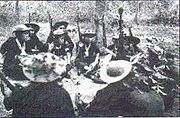
This capability to adapt was crucial when facing new technology
Technology
Technology is the making, usage, and knowledge of tools, machines, techniques, crafts, systems or methods of organization in order to solve a problem or perform a specific function. It can also refer to the collection of such tools, machinery, and procedures. The word technology comes ;...
, such as US helicopters. Several studies were conducted on how to combat the menace from above, and aiming and firing procedures were worked out for a variety of weapons, such as heavy machine guns. In one Viet Cong publication, shooting 1½ lengths ahead of the aircraft was deemed satisfactory for striking vital engine parts. Firing tables were also constructed and disseminated for different types of US aircraft. Countermeasures, including use of trenches and mines were also published for such armored vehicles as the M-113 personnel carrier
M113 armored personnel carrier
The M113 is a fully tracked armored personnel carrier that has formed the backbone of the United States Army's mechanized infantry units from the time of its first fielding in Vietnam in April 1962. The M113 was the most widely used armored vehicle of the U.S...
, which was often devastating to VC formations when first introduced.
"Bait" tactics and body counts
Both offensive and defensive tactics often involved luring ARVN and US troops into a maze of concealed fortifications, or into ambush positions, where they could be bled before the People's Army Forces withdrew. Initial positions were sometimes made to appear deliberately weak, including unmanned bunkers and light sniper-type resistance to bait enemy forces inside the killing zone. In the meantime, more lethal elements maneuvered and concentrated inside the fortified complex to inflict maximum damage.
Artillery
Originally applied to any group of infantry primarily armed with projectile weapons, artillery has over time become limited in meaning to refer only to those engines of war that operate by projection of munitions far beyond the range of effect of personal weapons...
and tactical air strikes after relatively token provocation. This created excessive destruction in the built up areas and radicalized the populace against the attacking troops.
Bait tactics exploited the US focus on body counts and its lavish use of firepower, including relatively ineffective Harassment and Interdiction (H&I) fire. One related method was to occupy a hamlet
Hamlet (place)
A hamlet is usually a rural settlement which is too small to be considered a village, though sometimes the word is used for a different sort of community. Historically, when a hamlet became large enough to justify building a church, it was then classified as a village...
or deploy near it, digging into positions at the treeline on the perimeter of the hamlet for attack or defense. ARVN or US forces would often counterattack by unleashing air and artillery strikes on the community, causing destruction to the persons and property of the civilians they were supposed to be protecting. The damage done, and protected by their dug-in positions, VC and PAVN fighters melted away at their earliest convenience, repeating the cycle elsewhere.
One US Army primer (Marshall and Hackworth 1967) on fighting Communist forces recognized these problems and counseled against hasty reaction fires, or careless advances on contact. Pressure from higher commanders for body counts in pursuit of the US attrition strategy contributed to these outcomes, often making a bad tactical situation worse in the view of these and other authors.
Mobility and movement
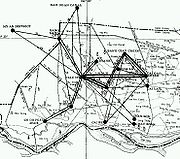
Bivouac shelter
A bivouac traditionally refers to a military encampment made with tents or improvised shelters, usually without shelter or protection from enemy fire or such a site where a camp may be built. It is also commonly used to describe a variety of improvised camp sites such as those used in scouting and...
in a series of fortified camps. These fortified sites could also be within villages or their subsidiary hamlets.
Constant shuttling between camps or "nomading," allowed the VC and NVA to evade detection and defend themselves. Just as important however, it allowed them to control an area's people, food and other material. As noted above, Main Force VC and NVA typically spent only a small number of days a year fighting. Most of the time was spent in area control, which provided recruits, food and other resources. Control of an area was achieved because the moving VC/NVA formations generally kept within striking distance of the civilian population and were thus in a position to harvest intelligence, liquidate opposition, intimidate the reluctant, and enforce demands for taxes, labor and other resources.
Movement procedures: Movement procedures varied with enemy locations, terrain etc., but generally recon elements from battalions or companies met with local guerrillas or operatives to gain intelligence, map out the terrain ahead, and obtain guides as needed. Security was on a tight basis with soldiers only being informed at the last minute. A movement order was accompanied by a thorough cleanup of the area to hide traces of the unit. Trenches, foxholes and other fortification
Fortification
Fortifications are military constructions and buildings designed for defence in warfare and military bases. Humans have constructed defensive works for many thousands of years, in a variety of increasingly complex designs...
s were generally camouflaged for later reuse.
Once on the move, an advanced recon team preceded the main body. Behind the advance troops, came the combat units, Headquarters, heavy weapons, combat support soldiers and another combat element. Trailing the formation was a rearguard
Rear guard
A rear guard or rearguard is that part of a military force that protects it from attack from the rear, either during an advance or withdrawal...
detachment. The distance between individual men was generally 5–10 meters - less during night movements. Complete radio silence was maintained during a movement, and strict camouflage and concealment procedures applied during day movement.
Recon elements scouted the flanks and rear extensively, especially while crossing obstacles or in enemy-held areas. Most movement was at night. Integral to any movement into a camp was the use of multiple avenues of approach, avoiding predictable patterns that could be exploited by opposing forces. When making an approach march for a planned battle, a long, roundabout route was generally taken, often criss-crossing earlier movements to fool enemy surveillance.
Signalling and communications: Communications relied heavily on field telephone and runner until the latter stages of the war when mostly conventional forces took the field. A simple signalling system via a series of gunshots was also used to communicate while moving in the jungle, with the pattern and sequence of the shots conveying meaning to other People's Army troops. When VC or NVA did acquire modern equipment via capture or supply, they made numerous attempts at communications deception, imitating US radio
Radio
Radio is the transmission of signals through free space by modulation of electromagnetic waves with frequencies below those of visible light. Electromagnetic radiation travels by means of oscillating electromagnetic fields that pass through the air and the vacuum of space...
transmissions and call signs to lure US/ARVN helicopters and troops into ambushes, or redirecting artillery fire from themselves on to US/ARVN positions via bogus requests for artillery adjustment and support.
Camp construction
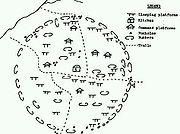
- Defense in depth
- Extensive use of camouflage
- Mutually supporting defensive networks
- Restricted avenues of approach
- Escape routes
- Use of tunnels, bunkers, communication trenches and foxholes
Also important was the requirement that the chosen location be within a single night's march of another camp. Special attention was paid to avenues of approach and withdrawal. VC and NVA battalions moved independently within their own sectors and along their own routes. A typical battalion might rotate between 20 and 25 campsites, all within a nights march of 3-4 other camps. While a US or ARVN attack might force them to fight, the primary mission was area control.
The standard camp was roughly circular and consisted of 2-lines of fortification, incorporating individual fighting positions, bunkers and trenches. Semi-permanent or permanent base camps contained more elaborate fortification (Defensive tactics). A typical VC/NVA battalion generally spread out its companies at one-hour intervals across an area, balancing the need for quick dispersal with opportunity to concentrate as needed.
Camps were not necessarily in remote areas. They were often situated near hamlets, or even within them - with troops taking shelter in individual houses if the village was fully dominated by the liberation forces. After digging in, telephone wire was run, units positioned and contact made with other surrounding military
Military
A military is an organization authorized by its greater society to use lethal force, usually including use of weapons, in defending its country by combating actual or perceived threats. The military may have additional functions of use to its greater society, such as advancing a political agenda e.g...
formations - especially militia
Militia
The term militia is commonly used today to refer to a military force composed of ordinary citizens to provide defense, emergency law enforcement, or paramilitary service, in times of emergency without being paid a regular salary or committed to a fixed term of service. It is a polyseme with...
and guerrilla fighters. These local units were crucial in warning, diversion and delay of GVN or US forces if the Main Force element came under attack. Communist forces generally avoided villages with high canal banks, graveyards or trees because such obstacles hindered observation and gave advancing US and ARVN troops cover. Mines and booby traps were also planted along likely avenues of approach.
Camp life and morale
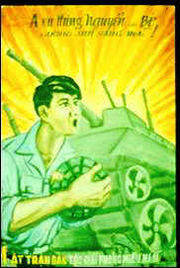
Food supplies were, like those of other armies, designed to keep the troops at a certain level of activity rather than be tasty. VC/NVA fighters received a daily cash allowance for food which they might sometimes use in local markets. They also foraged widely including hunting. Lacking refrigeration, most food was prepared fresh. Rice was the staple. The ingenious Hoang Cam stove was used to prepare meals without flame or smoke being detected, incorporating a long exhaust trench that allowed smoke to gradually disperse into the jungle far away from the actual stove.
Recreation was provided by well organized troupes of actors and musicians when feasible, unit papers and radio broadcasts. As in all things, these were monitored by Party cadres
Professional revolutionaries
The concept of professional revolutionaries, alternatively called cadre, is in origin a Leninist concept used to describe a body of devoted communists who spend the majority of their free time organizing their party toward a mass revolutionary party capable of leading a workers' revolution...
to ensure the proper line was disseminated. Medical care was difficult and austere in wartime conditions, and medicines and facilities lacking, nevertheless the highly organized system provided a rudimentary level of care to injured fighters, with field hospitals sometimes located in underground tunnels, caves and bunkers.
Defensive tactics
VC/NVA defensive doctrine generally stressed avoidance of extended battle. Unless an enemy sweep, or patrol provoked an engagement, communist forces generally lay low until they were ready to initiate their own actions. If an engagement ensued, the typical approach in terms of defense was to delay opposing forces and withdraw as soon as possible, while inflicting maximum casualties before withdrawal. Massive US "search and destroy" sweeps for example, while of unmistakable value in area denial, dispersal of opponents etc., yielded mixed results in the face of such avoidance tactics.The biggest such operation, "Operation Junction City" in 1967 for example, involving some 22 US battalions and 4 ARVN counterparts, and supported by massive air and artillery firepower, only yielded an average of approximately 33 enemy dead per day, over its 2 months. Such losses were manageable by an opponent that could put tens of thousands of staunch fighters in the field, and reinforce them with more every day. Even more telling, such massive sweeps failed to cripple their targets and deliver the big battles sought by the Americans. The option of initiating contact was still largely in the hands of Communist units, and their tactics lured powerful US forces away from populated areas, their key base until late in the war.
A key part of the avoidance defensive pattern also involved the intensive use of fortifications and mines. Both served to enable Front forces to escape for another days fighting, while running up the enemy tab in blood and treasure.
Defensive layouts: the two-belt system
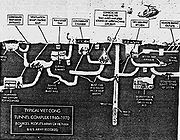
In villages the VC and NVA followed the same 2-belt approach, placing defenses so they were integrated with village homes and structures. This took advantage of some US Rules of Engagement
Rules of engagement
Rules of Engagement refers to those responses that are permitted in the employment of military personnel during operations or in the course of their duties. These rules of engagement are determined by the legal framework within which these duties are being carried out...
limiting or delaying the use of heavy weapons in inhabited areas. Another benefit of embedding defenses among civilians was that atrocities could be charged if civilian structures were hit by US or ARVN fire. Numerous dummy positions were also constructed to draw ARVN and American fire. In more remote areas, defensive fortifications were more elaborate, sometimes incorporating a third belt of defenses with stronger bunkers and trench systems. US attacks against such tough positions sought to avoid US casualties by relying upon firepower.
In some circumstances Front fortifications did not follow the layout scheme described above. Bunkers and fighting holes were scattered more widely to delay attackers, and create the psychological impression that they were surrounded on all sides. Lookout posts were often positioned on key trails, routes and likely US helicopter landing zones. To enhance their mobility during a defensive battle, numerous air-raid shelters, bunkers and trenches were pre-built in advance around an area of operations. This involved an enormous amount of labor but proved their value in maneuvering under ARVN/US attacks. Foxholes dug by VC troops during the victorious Battle of Ap Bac
Battle of Ap Bac
The Battle of Ap Bac was a major battle fought on January 3, 1963, during the Vietnam War. It was fought in Dinh Tuong Province , South Vietnam. On December 28, 1962, U.S...
are testimony to the insurgents almost religious dedication to field fortifications. The holes were dug so deep that a man could stand inside. Excavation of dirt was from the rear, hiding telltale traces of the digging. Only a direct hit by an artillery shell or bomb could kill troops inside such holes. Behind the line of foxholes, the Viet Cong utilized and improved an irrigation ditch, allowing them concealed movement, communication and transmission of supplies on foot or by sampan. Most of these fighting positions were invisible from the air.
Booby traps and mines
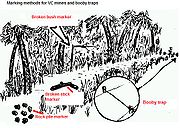
Land mine
A land mine is usually a weight-triggered explosive device which is intended to damage a target—either human or inanimate—by means of a blast and/or fragment impact....
caused immense psychological pressure on US and ARVN troops and also inflicted numerous casualties. By 1970 for example, some 11% of fatalities and 17% of injuries inflicted on US troops were caused by booby traps and mines. Identified by a variety of markers for friendly forces, these devices slowed operations, diverted resources towards security and clearance activity, damaged equipment and poisoned relations between soldiers and the surrounding civilian population.
Booby traps
Booby traps ranged from the simple to the complex. Non-explosive traps included the well-known sharpened punji stake
Punji stick
The Punji stick or Punji stake is a type of booby trapped stake. It is a simple spike, made out of wood or bamboo, generally placed upright in the ground. Punji sticks are usually deployed in substantial numbers....
coated in excrement, and mounted on sapling triggers and placed in shallow, covered pits. Stakes were deployed where infantry would walk or fling themselves to avoid attack such as roadside trenches, or behind logs. One of these devices was to injure a future Chairman of the US Joint Chiefs of Staff
Joint Chiefs of Staff
The Joint Chiefs of Staff is a body of senior uniformed leaders in the United States Department of Defense who advise the Secretary of Defense, the Homeland Security Council, the National Security Council and the President on military matters...
- Colin Powell
Colin Powell
Colin Luther Powell is an American statesman and a retired four-star general in the United States Army. He was the 65th United States Secretary of State, serving under President George W. Bush from 2001 to 2005. He was the first African American to serve in that position. During his military...
. Another type of trap was a spiked mud ball that swung down on its victim after a trip wire release, impaling him. Other impalement devices included bamboo whips and triggered sapling spikes. Bows with poisoned arrows were also used.
Explosive booby traps were also employed, some command detonated by hidden observers. They ranged from single bullets, to grenades, to dud bombs and shells. Anti-vehicle traps ranged from mines to buried artillery rounds. Helicopter traps were often deployed in trees surrounding a potential landing zone, trigged by an observer, or the rotor's wash.
Mines: the VC substitute for artillery
Mines caused even more damage than booby traps. According to one US Army history:
- "The enemy employed "nuisance mining," that is, scattering mines throughout an area rather than in well-defined minefields, on a scale never before encountered by U.S. forces. Mines and booby traps were usually installed at night by trained personnel who had detailed knowledge of the terrain. Through ingenious techniques in mine warfare, the Viet Cong successfully substituted mines and booby traps for artillery.
- Instead of conventional minefields covered by fire, the enemy hindered or prevented the use of supply roads and inhibited off-the-road operations by planting explosive devices in indiscriminate patterns. While he benefited directly by causing combat casualties, vehicle losses and delays in tactical operations, equally important was the psychological effect. Just the knowledge that a mine or booby trap could be placed anywhere slowed combat operations and forced allied troops to clear almost the entire Vietnam road net every day."
Hugging techniques, timings, counterattacks and withdrawals

Actions against enemy forces were often initiated in the latter part of the day, with impending nightfall providing favorable conditions for withdrawal. When surrounded, the Main Force VC and especially the NVA fought tenaciously, but usually with an eye towards withdrawal. Great efforts were made in recovering bodies, a psychological warfare measure that denied opponents the satisfaction of viewing enemy dead.
Invariably, VC and NVA units sought to withdraw if conditions were unfavorable, and camps and base areas were abandoned without sentiment if they became untenable. Rearguard detachments, mined routes, and diversionary attacks formed part of the retreat. The existence of cross-border sanctuaries in Laos, Cambodia and North Vietnam, where US ground troops could not follow greatly aided safe withdrawal of Communist formations.
There was a withdrawal scheme for all operations whether defensive or offensive. Escape and exit routes were pre-planned and concealed in advance, with later regrouping at a planned assembly point. Common techniques for withdrawal included the following:
- Fragmenting - splitting up in small groups when under attack, especially when trying to break through an encirclement.
- Dispersing - generally used when discovered. VC/NVA troops disperse, sometimes dropping packs to delay enemy forces who stop to inspect them.
- Hiding - VC/NVA troops spent a massive amount of time constructing fortifications and hiding places. Withdrawal movements frequently utilized these hideouts, often deep tunnel networks.
- Deceiving - conducting diversionary attacks to deceive and draw away enemy forces and thus facilitate the withdrawal.
- Delaying - use of rearguard units to delay pursuing forces. Delay units were sometimes used to setup enemy forces for an ambush, where the pursued turned on their pursuers.
Defensive measures against US aircraft
While their American opponents enjoyed air superiority, PAVN forces continuously challenged them, deploying an impressive array of ordinance to liquidate enemies from the air. The sophisticated missile defence system built with Soviet and Chinese assistance is well known, but PAVN made extensive use of anti-aircraft guns and even volume firing by ordinary soldiers. At the lowest level, one study noted that PAVN gunners were trained to use small arms against all types of aircraft, and special firing cells were established that could shoot up to 1000 rounds in 3 to 5 seconds at fast-moving jets. The volume of such firepower made life hazardous at the low levels for US planes, forcing them to move to higher altitudes, where the specialized anti-aircraft cannon took over. Special "bait" areas, ringed with hidden anti-craft batteries were also established to lure US aircraft. Barrage firing of many guns, mixed at various levels was also sometimes effective. Sensitive areas, such as Hanoi were the most heavily defended. Most US aircraft losses were caused by heavy automatic weapons and 14mm, 35mm 57mm and 85mm anti-aircraft guns. Flak batteries forced some US aircraft even higher, where they would be within reach of the deadly SA-2 missile batteries. Positioning automatic weapons at treetop level also aided in the struggle against US helicopters. Air losses were to cause a dip in the morale of American pilots, some of whom felt they were being called to risk their lives against targets of relatively little value. Appeals to US Defence Secretary McNamara to remove restrictions on more lucrative targets were often drastically pared down or vetoed. The inability of US airpower to take a decisive toll on communist forces is testimony not only to US failures, but to the tenacity of the ordinary PAVN soldier, both in direct combat with aerial enemies and in the massive effort spent in constructing sophisticated fortifications and tunnel systems. Such tenacity would achieve final victory after almost two decades of war.Offensive tactics
In offensive operations, the VC/NVA typically sought to wear their opponents down by thousands of small attacks, each one gradually reducing enemy strength. Winning and holding specific blocks of territory was not as important as wearing down the enemy in accordance with Mao's dictum: "To win territory is no cause for joy, to lose territory is no cause for sorrow." Bigger set-piece assaults on installations and bases as well as ambushes were sometimes executed, but the general pattern was one of protracted, attritional warfare, conducted by relatively small formations over a wide area. This meant absorbing large numbers of casualties, but both manpower and time were plentiful.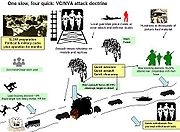
Attack planning
Planning for attacks was a careful, deliberate process, that could take many months. Below is an outline of some considerations and actions involved.Attack criteria and approval: The political dimensions of the attack were carefully considered, such as the timing of an election in the enemy camp, or the appointment of certain government officials. Planning involved a coordinated effort by military and logistics
Logistics
Logistics is the management of the flow of goods between the point of origin and the point of destination in order to meet the requirements of customers or corporations. Logistics involves the integration of information, transportation, inventory, warehousing, material handling, and packaging, and...
staff and the all-important political operatives, the party cadres who had the last word. Proposals for an operation were first sent up the chain of command. Depending on the scale of the planned operation, an idea to attack a certain village post might float up from Provincial, to Zone, to Interzone levels. Great stress was placed on a successful outcome that would be beneficial in terms of actual military results or propaganda. Numerical superiority was deemed essential.
Preliminary recon: If approved for further study, reconnaissance
Reconnaissance
Reconnaissance is the military term for exploring beyond the area occupied by friendly forces to gain information about enemy forces or features of the environment....
teams would case the area, analyzing political, logistics and military issues. Information gleaned from informers and sympathizers was joined to data from direct reconnaissance via patrols, infiltration or probing attacks. The analysis was comprehensive, and might involve size and composition of enemy forces, avenues of approach and withdrawal, civilian morale, hit lists of suspected traitors or troublesome dissenters who did not support the Revolution, available civilian labor to support logistics, detailed location of individual walls, ditches or fences and a host of other factors, both political and military.
Rehearsals for the attack: If the objective was deemed feasible along political and military lines, detailed planning for the actual operation began, including construction of sand tables, and string and stick mock-ups of the target. Main Force or regular units tasked with the assault were selected and rehearsed. Each phase of the attack was carefully reviewed and rehearsed, including actions before opening fire, actions during fire, and actions taken upon withdrawal. Numerous postponements and changes might be undertaken until conditions and preparations were judged right to launch the assault.
Logistics and security: Logistics formations might prepare coffins, pre-position medical or porter teams, and carefully tabulate the amount of ammunition needed for the operation. Guerrilla elements and laborers began to move supplies and material forward to support the impending battle. Security surrounding the operation was usually very tight with units only being informed at the last feasible moment.
Echelons of attack: Depending on the complexity of the attack, numerous sub-divisions might be involved. Local guerrillas might conduct certain preliminary tasks, such as diversionary attacks, or clearance or denial (via mining, booby traps etc.) of certain areas for movement purposes. Sappers might be tasked with opening the assault via infiltration and demolition of key objectives. A main force might swing into action once the sappers commenced their action. A blocking force might be deployed to ambush relief troops rushing to the battle area.
Attack doctrine: "one slow, four quick"
The discussion on VC/NVA offensive methods below is adapted from Bernard B. Fall, Street without Joy; Michael Lee Lanning and Dan Cragg, Inside the VC and the NVA; and United States Army Center of Military History: Vietnam Studies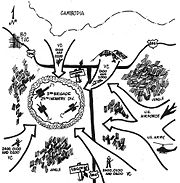
Slow Plan - This involved a steady but low-key logistical build up in forward supply areas, being positioned ahead of the fighting forces to make a solid base for the operation. The degree of planning and preparation necessary to undertake a large operation could take as long as 6 months and often included numerous 'rehearsals'.
- Quick Advance - This was a rapid movement forward, generally after a circuitous approach march meant to confuse the enemy. Once all the units in the operation were on track, a quick advance was usually made in small and inconspicuous groups to a forward staging area from where the attack would be launched.
- Quick Attack - Here the attacking forces would be concentrated at the weakest point of the target as identified by prior reconnaissance. The duration of an attack could often be measured in minutes. Surprise was essential and large volumes of fire were poured on the target. Phase 2 of the attack involved the three strongs:
-
-
- Strong fight - an attempt to achieve and exploit the element of surprise
-
-
-
- Strong Assault - against a pre-arranged position using concentration of force, effort and mass to overwhelm the defense.
-
-
-
- Strong pursuit - the attacking force's reserves would be committed to exploit the breaches in the targets defenses so as to deliver a decisive blow
-
- Quick Clearance - The attacking force would rapidly re-organize and police the battlefield so as to remove weapons and casualties and was pre-planned to prevent confusion on the objective
- Quick Withdrawal - Involved a quick egress from the battle area to a pre-arranged rendezvous point where the attackers would again break down into smaller groups to continue their dispersal.
Anatomy of an attack: Lima Site 85 Radar station - Laos 1968
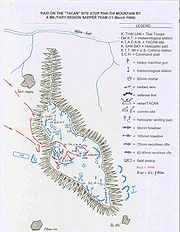
Echelon formation
An echelon formation is a military formation in which members are arranged diagonally. Each member is stationed behind and to the right , or behind and to the left , of the member ahead...
of NVA and Pathet Lao assaulted the rest of the mountain slopes below. The outgunned and outnumbered Hmong and Thai irregulars were defeated, and Communist forces held the site despite several days under counterattack by US aircraft.
A full after-action report by PAVN was translated in 1986 and along with other US reports, furnishes numerous details about offensive tactics. These include extensive preliminary recon and rehearsals, vetting and clearance by Communist Party operatives, numerical superiority at the point of attack (3,000 versus 1,000), a secure advance to the objective (avoiding or hiding from civilian traffic), detailed sub-division of tasks for each assault element, rapid movement once the battle began, and cooperation between special forces (sappers), regulars, and local guerrillas. This operation did not involve the typical quick withdrawal however. The attackers dug in on the site and defended it against counterattack, a pattern that occurred when the VC/NVA wanted to inflict maximum casualties, or achieve some political or propaganda objective, or control a particular area.
In this case, the radar station helped guide US bombers - including the devastating B-52s, and its capture was also a strong propaganda bonus demonstrating Communist strength in Laos to the local peoples. The base was isolated and superior forces could be concentrated on it, maximizing chances for success - a key consideration in a VC/NVA offensive operation. The raid also illustrated another method of neutralizing US airpower- attack its support facilities and bases on the ground. Subsequent attempts by Royal Laotian forces to retake the area were only partially successful. The mountain peak was never recaptured.
Ambush techniques

Ambush
An ambush is a long-established military tactic, in which the aggressors take advantage of concealment and the element of surprise to attack an unsuspecting enemy from concealed positions, such as among dense underbrush or behind hilltops...
had to meet strict criteria:
- provide concealment to prevent detection from the ground or air
- enable ambush force to deploy, encircle and divide the enemy
- allow for heavy weapons emplacements to provide sustained fire
- enable the ambush force to set up observation posts for early detection of the enemy
- permit the secret movement of troops to the ambush position and the dispersal of troops during withdrawal
One important feature of the ambush was that the target units should 'pile up' after being attacked, thus preventing them any easy means of withdrawal from the kill zone and hindering their use of heavy weapons and supporting fires. Terrain was usually selected which would facilitate this and slow down the enemy. The terrain around the ambush site which was not favorable to the ambushing force, or which offered some protection to the target, was heavily mined and booby trapped or pre-registered for mortars.
Ambush units: The NVA/VC ambush formations consisted of:
- lead-blocking element
- main-assault element
- rear-blocking element
- observation posts
- command post
Other elements might also be included if the situation demanded, such as a sniper screen along a nearby avenue of approach to delay enemy reinforcement.
Command posts: When deploying into an ambush site, the NVA first occupied several observation posts, placed to detect the enemy as early as possible and to report on the formation it was using, its strength and firepower, as well as to provide early warning to the unit commander. Usually one main OP and several secondary OP's were established. Runners and occasionally radios were used to communicate between the OP's and the main command post. The OP's were located so that they could observe enemy movement into the ambush and often they would remain in position throughout the ambush in order to report routes of reinforcement and withdrawal by the enemy as well as his maneuver options. Frequently the OP's were reinforced to squad size and served as flank security. The command post was situated in a central location, often on terrain which afforded it a vantage point overlooking the ambush site.
Recon methods: Recon elements observing a potential ambush target on the move generally stayed 300–500 meters away. Sometimes a "leapfrogging" recon technique was used. Surveillance units were echeloned one behind the other. As the enemy drew close to the first, it fell back behind the last recon team, leaving an advance group in its place. This one in turn fell back as the enemy again closed the gap, and the cycle rotated. This method helped keep the enemy under continuous observation from a variety of vantage points, and allowed the recon groups to cover one another.
Ambush considerations

The preferred time for ambushes was just before dark. Enemy units were often deliberately delayed by the deployment of small patrols or snipers which harassed it. Roads and bridges to the rear of the enemy unit would also be sabotaged or mined to prevent withdrawal. This limited the enemy's use of air support and the deployment of reinforcements. It often also resulted in the ambushed unit being pinned in place for the night and having to set up a defensive perimeter in a hostile area.
All ambushes, in keeping with universal ambush doctrine, were intended to inflict maximum casualties on the enemy and to allow the ambushing force to withdraw before effective fire could be returned.
Ambush types
The NVA/VC favored seven types of ambushes; Mine, Bloody Nose, Flank, L-shaped, Maneuver, V-shaped, and Z-shaped. The following discussion is adapted from the MACV monograph (Counterinsurgency Lessons Learned No 60, 1966) and from the US Army's Handbook: ("What A Platoon Leader Should Know about the Enemy's Jungle Tactics," 1967)Mine Ambush.
This depended on the use of command-detonated mines which were triggered by hidden troops who held a detonating device connected to the demolitions by electrical wire. Mine ambush kill zones might also include punji traps or other homemade traps, land mines and natural obstacles. However, the ambush was always triggered by electrically detonating a mine, when enemy troops moved within the mines killing range.
Bloody Nose Ambush.
Used by small units against larger enemy forces as a means of harassment, delay and disruption. By positioning the ambush to enfilade
Enfilade and defilade
Enfilade and defilade are concepts in military tactics used to describe a military formation's exposure to enemy fire. A formation or position is "in enfilade" if weapons fire can be directed along its longest axis. A unit or position is "in defilade" if it uses natural or artificial obstacles to...
an avenue of approach, the NVA/VC obtained more effective results. Minefields, mantraps and booby traps were placed along both sides of the trail and perpendicular to it. As the enemy unit came under fire and attempted to maneuver right or left to close with the ambushers, the protective barriers would inflict casualties. As soon as the ambushing element realised that the enemy had advanced into, and taken casualties from, the mine/trap line, the ambushers withdrew to another pre-selected site where they might repeat the maneuver.
Flank or Linear Ambush.
This was one of the simplest to set up and operate and was most commonly used by the NVA. It was also easy to get into and away from quickly. The ambush position was laid parallel to the target area. Mines or other obstacles were placed on the other side of the ambush site. Upon command, fire was brought to bear on the kill zone from multiple, overlapping firing positions. The linear ambush pumped bullets into the flank of a surprised enemy column.
The 'L' Ambush.
L-shaped ambushes included the most effective aspects of both the 'Bloody Nose' and Linear ambush. The short end, or base, of the 'L' was positioned so that at least one machine gun could fire straight down the kill zone, enfilading it. Parallel to the kill zone and tied into the 'L' was a second, flanking ambush.
The 'L' shaped ambush could also provide its own flank security. The base of the 'L' might be placed along either flank of the ambush position, not to fire into the kill zone, but to ambush enemy units that were attempting to flank the main ambush position along obvious avenues of approach.
In some situations the enemy located a reserve unit in line with the vertical bar of the 'L' forming a 'T' ambush. After the ambush was sprung, the enemy maneuvered his reserves to block the enemy line of withdrawal. The reserves either close assaulted or set up another ambush along the first linear obstacle to the immediate rear of the kill zone.
The Maneuver Ambush.
This was usually directed against a road bound column of vehicles. The NVA/VC usually sprang it from high ground, near a bend in the road, which allowed cover and longer fields of fire for automatic weapons. Weapons frequently opened fire from positions within forty yards of the road or less.
A road bend was included in the kill zone so that the end of the column was out of sight of the head of the column when the ambush was sprung. Interruption of a column's front-to-rear line of sight increased the likelihood that the head and tail of the column would split and try to fight separately.
The ambush was initiated by a small element striking the head of an enemy column and stopping it by fire. Then the main body would attack the column from the rear and/or flank, fragmenting it and rolling it up. The two strikes were timed close enough together so that the target column was engaged from both ends before it could deploy and face toward either danger.
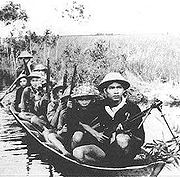
Positioned with its open mouth toward the enemy advance, this was a favourite of the VC. It was used in both fairly open terrain as well as jungle. The ambushers, in good concealment along the legs of the 'V', would wait until the enemy point had passed and then creep close to the trail. The 'V' ambush was virtually undetectable by enemy point or flank security until at least a portion of the enemy force was in the kill zone. Enfilading fire was often directed down the enemy axis of advance, and interlocking fire from each leg across the 'V'. The 'V' ambush also lent itself to the use of controlled mines and booby traps.
The 'Z' Ambush.
Usually laid along a road, the 'Z' ambush was both effective and confusing to the unit being ambushed. This complicated ambush was usually well planned with low bunkers lining the kill zone, often prepared months prior to the ambush. The ambush position was only occupied after word was received that an enemy battalion or larger unit would be using the road, which passed through the ambush site.
The long end of the 'Z' ambush was located on one side of a trail or road enabling the ambushers to employ both enfilading and flanking fire. It was also placed to neutralise attempts to flank the ambush from nearly every direction. Ambushing units deployed along the two short ends of the 'Z' could fire in either direction. The 'Z' ambush was dangerous to ambushers because ambush elements could easily fire into each other.
Effectiveness of ambushes
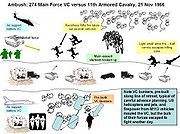
The encounter between the 274th VC Main Force Regiment and the US 11th Armored Cavalry shown in the diagram above illustrates several facets of the contending forces. The ambush took place on Highway 1, a vital road artery close to Saigon. There seems to have been careful preparation by Communist forces, including pre-built bunkers to shelter troops from US firepower along the line of retreat. A number of vehicles were destroyed but US airpower broke up the VC concentrations. A follow-up sweep by US forces killed a small number of additional VC but the bulk of them escaped.
VC formations continually refined their techniques. At the Battle of Ong Thanh
Battle of Ong Thanh
The Battle of Ong Thanh was fought on the morning of October 17, 1967, in Binh Duong Province, South Vietnam. During the first few months of 1967, the Viet Cong absorbed heavy losses as a result of large-scale search and destroy missions conducted by the United States Army, and it prompted North...
in 1967 they sprung another ambush, inflicting heavy casualties on American troops. In this encounter the VC used a variety of methods to neutralize dreaded US firepower, including "hugging" or fighting close to US troops. They also moved rapidly parallel to the line of ambush, sliding along its length and thus presenting a harder target for American counter-attack. While US firepower caused significant losses for the VC throughout the conflict, these methods show a force that was learning, adapting, and growing more proficient on the battlefield. Time as always, still favored Communist forces. Sanctuaries in Laos, Cambodia and North Vietnam were always available, forbidden to US ground attack. Inevitably, the ARVN and Americans would have to move on. The VC and NVA regrouped and returned.
Sapper organization
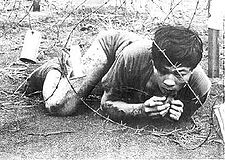
NVA
NVA is a three-letter acronym for:*National People's Army, or Nationale Volksarmee, the army of former German Democratic Republic*Nieuw-Vlaamse Alliantie, a Flemish political party also known as New-Flemish Alliance...
used special assault troops or sapper
Sapper
A sapper, pioneer or combat engineer is a combatant soldier who performs a wide variety of combat engineering duties, typically including, but not limited to, bridge-building, laying or clearing minefields, demolitions, field defences, general construction and building, as well as road and airfield...
s for a wide range of missions, sometimes by themselves, or sometimes as spearheads for a main-force echelon. The Viet Cong also deployed sappers particularly after Tet Offensive losses had made large-scale attacks hazardous. Called dac cong by the Vietnamese, sappers were a force economy measure that could deliver a stinging blow. They were an elite, especially adept at infiltrating and attacking airfields, firebases and other fortified positions. About 50,000 men served in PAVN as sappers, organized into groups of 100-150 men, further broken down into companies of roughly 30-36 men, with sub-divisions into platoons, squads and cells. Specialist troops such as radiomen, medics, and explosives experts were also attached. Many were volunteers. Sappers were often assigned to larger units (regiments, divisions etc.) - carrying out attacks and recon duties, but could also be organized as independent formations. Sappers trained and rehearsed carefully in all aspects of their craft and made use of a variety of equipment and explosive devices, including captured or abandoned American munitions. Sappers also carried out intelligence missions and could work undercover. One of the sappers in the spectacular 1968 Tet Offensive attack against the US Embassy for example, was once a driver to the US Ambassador.
Sapper techniques
Assault planning. As with most VC Main Force/PAVN operations, the general doctrine of "one slow, four quick" was followed - slow recon and initial penetration, then fast approach, attack, clearance and withdrawal. A typical assault began with a detailed recon of the target- pinpointing bunkers, ammo dumps, command and communications centers, barracks, power generation facilities and other vital points. Data from many other sources (farmers, spies, informers etc.) was collected and added to this. Detailed mortar ranges to each target area were plotted. A mock-up of the target was created and detailed rehearsals took place. Assaults were usually planned after nightfall. Signalling systems were sometimes devised using colored flares. A typical signal package by the assault teams might be as follows: red flare: area hard to get into; white flare: withdrawal; green flare: victory; green followed by white: reinforcements requested.Assault organization and formations. Depending on the size of the attack, sappers were usually divided into 10-20 man assault groups, which were further subvivided into 3-5 man assault teams or cells. Each was tasked with destroying or neutralizing a specific area of the enemy defense. Four echelons might be employed on a typical sapper operation. An Assault group took on the main burden of the initial penetration through the wire and other defenses. A Fire-support group might be used to lay down covering fire via RPGs, mortars or machine guns at key points such as when the penetration elements cleared the wire, or at a set time, or via a pre-arranged signal. A small Security group might be deployed to position themselves to ambush reinforcements that attempted to rush to the defense of the besieged area. A Reserve group might be held back to exploit success, mop up or extract their fellow soldiers if the situation began to deteriorate. Deployment of these elements depended on the target and available forces. In larger attacks, where the sappers were to lead the way, the fire support, exploitation or security roles might be undertaken by bigger echelons of regular follow-on forces which used breeches created by the sappers to conduct their operations.
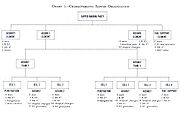
Tripflare
A tripflare is a device used by military forces to secure an area and to guard against infiltration. It consists of tripwire around the area, linked to one or more flares. When the tripwire is triggered, as by someone unsuspectingly disturbing it, the flare is launched and begins burning...
s were neutralized by wrapping their triggers with cloth or strips of bamboo carried in the teeth of the vanguard fighters. Claymore mines might be turned in another direction.
A point man usually preceded each team - crawling silently through defenses, probing with his fingers to detect and neutralize obstacles, while the others followed behind. Sometimes gaps in the wire were created by tying down strands to make an assault corridor. Woven mats might be thrown over barbed wire to facilitate passage. Sappers often used Bangalore torpedo
Bangalore torpedo
A Bangalore torpedo is an explosive charge placed on the end of a long, extendible tube. It is used by combat engineers to clear obstacles that would otherwise require them to approach directly, possibly under fire...
es made from blocks of TNT tied to bamboo poles to blast open assault routes. Attack routes often took unexpected avenues of approach, such as through the trash pits of US Firebase Cunningham in 1969.
The main attack and withdrawal. Based on the target and relevant military situation, some attacks proceeded mainly by stealth, with little initial covering fire until the last moment. Breaches might be created in the wire at several points, then left open while the penetration teams aligned with their objectives, and hunkered down, awaiting the hour of decision. Other strikes, particularly against heavily defended US targets used a barrage of covering fires to keep defenders penned in their positions, heads down, while the assault groups moved stealthily into position. Targets were usually hit in priority order- according to the level of danger they presented to the sapper units, or based on relevant military or political objectives. Emphasizing utmost ruthlessness in attack, the sub-doctrine of the "3 strongs" (surprise, concentration of force and exploitation of success) was generally followed.
If discovered, the sappers often sprang up and attacked immediately. Diversionary assaults and fires were also created to screen the main sapper effort. Once the fierce fighting of the main phase was over, the pullout began. While small rearguard type elements might be left in place for delaying or diversionary purposes, withdrawal was generally a quick affair. Valuable enemy weapons and other equipment were rounded up, and the bodies of the dead and wounded were removed. Detailed after-action reports and critiques were conducted by VC/PAVN forces, absorbing lessons learned and sharpening their skills for the next assault.
Sapper attack on 242d Aviation Company - Cu Chi, 1969
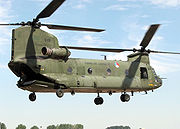
POW interrogations revealed close coordination with local guerrilla elements and informers, including provision of detailed drawings and sketches of the target area. Penetration teams achieved almost complete surprise, with the sappers cutting 10 barbed wire fences, and advancing without being detected by sentries, obstacles or patrols. A rocket attack was the signal for the sappers to go into action against the helicopters and soldiers. Aside from the aircraft, US troop losses were comparatively light (1 dead, 3 wounded versus some 30 NVA or VC dead), nevertheless the incident reveals the ability of the VC/NVA to stay in the field while they rebuilt after the losses of Tet.
Sapper attack on Firebase Mary-Ann, 1971
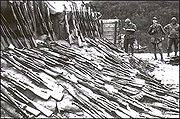
Flare (pyrotechnic)
A flare, also sometimes called a fusee, is a type of pyrotechnic that produces a brilliant light or intense heat without an explosion. Flares are used for signalling, illumination, or defensive countermeasures in civilian and military applications...
in the wire surrounding the complex. These had not been replaced when the attack came. A mortar barrage was laid down at a set time to open the battle. This provided cover for the sappers, who were already pre-positioned far forward, to move quickly towards their objectives. They destroyed the Battalion Operations Center and a number of command posts, and created general mayhem before withdrawing when helicopter gunships arrived.
The final US toll was almost 30 dead and 82 wounded. Suspicion still lingers about this controversial attack, including charges that VC infiltrators posed as ARVN soldiers to facilitate the assault. If so, the incident demonstrates the long reach of the VC intelligence services, and their sophisticated planning and execution of the assault. Several senior American commanders were relieved of duty or were reprimanded after the event. Audaciously, the VC attacked the ruins of the firebase the following day with machine gun fire. One Vietnam historian calls this incident the “U.S. Army's "most blatant and humiliating defeat in Vietnam." Others dispute this characterization.
Improvements in PAVN performance over the 1972 Offensive
Assessment of VC/NVA performance must look beyond the American interlude, and the guerrilla warfare phases to the final outcome ofthe Vietnam War in 1975. Well before the end, the Viet Cong were reduced to a minor force, and regular PAVN formations controlled the field. While final victory was aided by absence of American airpower, the PAVN/VPA armies were no longer the light-infantry formations mauled at the la Drang in 1965, but a tough, proficient, well-equipped modern force. Their capabilities had grown considerably, and several shortcomings of the conventional 1972 Easter Offensive were remedied.
In 1972 there was distinct weaknesses in the coordination of armor, artillery and infantry, with the three fronts of advance failing to support one another satisfactorily. Armored forces were often committed in penny packets, with lack of effective infantry
Infantry
Infantrymen are soldiers who are specifically trained for the role of fighting on foot to engage the enemy face to face and have historically borne the brunt of the casualties of combat in wars. As the oldest branch of combat arms, they are the backbone of armies...
support and artillery co-operation, making them vulnerable to US and ARVN countermeasures. The logistics system was also unable to support the tempo of full-scale conventional battle. By 1975, these weaknesses had been substantially corrected, and a sophisticated military machine attained a rapid victory. The Ho Chi Minh Trail
Ho Chi Minh trail
The Ho Chi Minh trail was a logistical system that ran from the Democratic Republic of Vietnam to the Republic of Vietnam through the neighboring kingdoms of Laos and Cambodia...
was increasingly a network of paved roads easing the logistical flow for the Offensive and tactical concentration and coordination of infantry, armor and artillery was much tighter.
Integral to the PAVN advance was combined infantry and armor columns, that threw ARVN opponents off balance with swift moves and rapid concentrations. Extensive use was made of the "blooming lotus" tactic to assault cities and towns. Rather than surround them and work inward in the orthodox manner of many contemporary Western armies, PAVN mobile columns bypassed opposition on the target's perimeter, and drove inward to seize vital command and control nodes in the central areas first, before striking outward to liquidate opposition. A reserve force was held on standby to defeat counterattacks against the penetration force.
A leap-frogging tactic was also employed to maintain momentum. Spearhead units would sometimes deploy quickly to tackle opposition, while follow-on echelons bypassed such engagements to strike deeper. Infiltration units like sappers also assisted the push by seizing bridges, road junctions and other key points ahead of the main forces. Deception measures were also widely used, with diversionary operations across a broad area, and troop movements timed until the last minute, to avoid telegraphing the main points of attack. Such methods for example, enabled quick conquest of towns like Ban Me Thuot and their surrounding highways, and paved the way for further operations towards Saigon.
Terror and panic played their part in the NVA/PAVN advance, particularly in the Central Highlands
Tây Nguyên
Tây Nguyên, translated as Western Highlands and sometimes also called Central Highlands, is one of the regions of Vietnam. It contains the provinces of Đắk Lắk, Đắk Nông, Gia Lai, Kon Tum, Lâm Đồng....
where 5 rapidly moving divisions overwhelmed hapless ARVN formations. During the retreat from the Highlands, massive columns of civilian refugees mingled with fleeing South Vietnamese troops. PAVN forces shelled these columns indiscriminately with mortars, rockets and artillery, killing over 100,000 civilians by some estimates, and liquidating some 40,000 out of 60,000 retreating ARVN soldiers.
PAVN as a modern, professional army

Ho Chi Minh Campaign
The Hồ Chí Minh Campaign was the final title applied to a series of increasingly large-scale and ambitious offensive operations by the Democratic Republic of Vietnam and the National Front for the Liberation of South Vietnam which began on 13 December 1974...
) sealed the doom of a troubled force.
Such weaknesses were skillfully exploited by the fast-moving Northern conquest, in a final campaign that illustrates a coming of age for the PAVN forces in the minds of some Western historians.
-
- "Almost a quarter century ago, a third world country won the final battle of a long and difficult war through the use of an unexpected and decidedly modern strategy. The tutorial embodied in this victory is worth remembering today, in an age when there is a tendency to rely more on technology than on strategy and to assume that our enemy's strategic skills are as backward as his nation's economy, social structure and technological base...
-
- For the first time, PAVN's campaign strategy was not based primarily on the demonstrated willingness of its troops to die in greater numbers than those of its opponents. Moreover, it paid only lip service to the old dogma of a popular uprising. The PAVN campaign relied instead on deception, diversion, surprise, an indirect approach and alternate objectives - in short, a highly cerebral strategy. PAVN finally mounted a campaign worthy of the modern, professional army the Vietnamese communist leadership worked so long to build.."
Focus on American versus Vietnamese perspectives
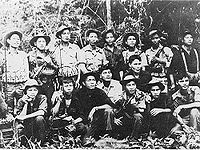
Da Nang
Đà Nẵng , occasionally Danang, is a major port city in the South Central Coast of Vietnam, on the coast of the South China Sea at the mouth of the Han River. It is the commercial and educational center of Central Vietnam; its well-sheltered, easily accessible port and its location on the path of...
in March 1975 cost the South Vietnamese an estimated 60,000 deaths, more than total US military losses for the entire conflict.
There is often heavy concentration on the American effort and its mistakes, contradictions and strategy, but comparatively little on the Vietnamese side, save as it ties into the theme of American failure or missteps. Whatever the merits of these arguments about war coverage, it is clear that the main 8-year American interlude (albeit important) was only a relatively short one in the decades-old struggle for hegemony
Hegemony
Hegemony is an indirect form of imperial dominance in which the hegemon rules sub-ordinate states by the implied means of power rather than direct military force. In Ancient Greece , hegemony denoted the politico–military dominance of a city-state over other city-states...
in the Second Indochina (Vietnam) War. Primary responsibility for victory in that struggle goes to the formidable, totally mobilized political and military machine that was North Vietnam. The spearhead of that machine was the VC/NVA forces.
VC/NVA battlefield performance
VC/NVA performance waxed and waned with the fortunes of war. Weapons and equipment at the small arms level were equal with those of their enemies, and in some categories of heavy artillery they also achieved parity. The struggle against US bombing saw deployment of one of the most sophisticated air defence systems in the world, albeit with Soviet assistance. In other categories they could not match the wide range of advanced US technology.Against their ARVN opponents the VC/NVA generally did well in both guerrilla and conventional warfare, and were on the verge of victory in 1965, before the American intervention. While ARVN forces achieved a number of impressive successes, they were, on balance, clearly outclassed by the PAVN armies, which suffered from weaknesses in certain areas, such as airpower and the handling of armor- illustrated particularly in the 1972 Easter Offensive. Subsequent campaigns in Indochina however, illustrate a number of PAVN strengths - from the rapid victory of 1975, to the initial 1979 invasion of Cambodia which saw well coordinated corps
Corps
A corps is either a large formation, or an administrative grouping of troops within an armed force with a common function such as Artillery or Signals representing an arm of service...
-sized combined arms operations including an amphibious assault against the coast. PAVN strengths were also shown in its defensive operations during the 1979 Sino-Vietnamese War
Sino-Vietnamese War
The Sino–Vietnamese War , also known as the Third Indochina War, known in the PRC as and in Vietnam as Chiến tranh chống bành trướng Trung Hoa , was a brief but bloody border war fought in 1979 between the People's Republic of China and the Socialist Republic of Vietnam...
.

Linchpin
A linchpin, also spelled linch pin, lynchpin, or lynch pin, is a fastener used to prevent a wheel or other rotating part from sliding off the axle it is riding on. The word is first attested in the 14th century and derives from Middle English elements meaning "axletree pin".Securing implements onto...
of their protracted war strategy, kept their forces intact until this formidable opponent withdrew.
Elements in NLF/PAVN triumph
There are numerous keys to the final outcome of the Vietnam War. A few of these interrelated factors are summarized below:- A protracted, integrated strategy that maximized Northern strengths against the weaknesses of their Southern and American opponents. This was the strategy of protracted war, that tightly integrated political and military factors, and slowly weakened opposition over time by an attritional campaign. Protracted war also involved sequencing a mix of combat styles. This ranged from small scale guerrilla attacks, to main-force battles that even when costly, atrophied enemy strength and morale. It also drew powerful US forces into peripheral areas, while allowing VC/NVA forces to control the key to any People's War, the population. All these measures were keyed to political ends, and included ruthless assassination, kidnapping and sabotage efforts throughout the war. To some US soldiers who fought against the VC/NVA, like US Lt. GeneralLieutenant GeneralLieutenant General is a military rank used in many countries. The rank traces its origins to the Middle Ages where the title of Lieutenant General was held by the second in command on the battlefield, who was normally subordinate to a Captain General....
Phillip DavidsonPhillip DavidsonPhillip Buford Davidson, Jr. was an American Lieutenant general, who served in World War II, the Korean War, and the Vietnam War....
, Chief of Military Intelligence from 1967 to 69, and US war historians like Andrew F. Krepinevich Jr.Andrew KrepinevichAndrew F. Krepinevich, Jr. is a defense policy analyst, currently executive director of the Center for Strategic and Budgetary Assessments. His influential book, The Army and Vietnam, contends that the United States could have won the Vietnam War had the Army adopted a small-unit pacification...
this strategy was a superior one in terms of Communist objectives and strengths, and American/GVN weaknesses. - Detailed, overlapping organization backed by thorough going indoctrination. Historian Douglas Pike in 'Viet Cong' (1966) asserts that the closest thing to a "secret weapon" of the revolutionary forces was organization - tight, overlapping mechanisms of structure that enmeshed its subjects in a tight web of control. This structure included the parallel system of party control at all levels of civilian and military life, the overlapping plethora of organizations from province to village hamlet that enhanced resource exploitation, the three-man cells all troops were organized into, and the heavy use of "criticism and self-criticism" that pervaded all levels. One American Vietnam War historian calls the Viet Cong "more disciplined and organized than nearly any insurgents in history."
- Lavish logistical, military, political and diplomatic support by friendly communist nations. Aid from China and the Soviet Union was indispensable to the tough military machine on the ground, and the equally tenacious machine on the diplomatic and political fronts. This aid made North Vietnam dependent on their suppliers, but it was able to play one off against the other to enhance their bargaining power and maintain a stance of relative independence.
- Logistical resilience and manoeuvring space. The enormous, and successful Communist logistics effort in the face of devastating enemy firepower provided another key to victory. Supplied by supportive socialist allies, distribution to the battle zone, utilizing the manoeuvring space that was the Ho Chi Minh and Sihanouk TrailSihanouk TrailThe Sihanouk Trail was a logistical supply system in Cambodia used by the People's Army of Vietnam and its National Front for the Liberation of South Vietnam allies during the Vietnam War...
s was an impressive logistical feat. This vast space - encompassing parts of LaosLaosLaos Lao: ສາທາລະນະລັດ ປະຊາທິປະໄຕ ປະຊາຊົນລາວ Sathalanalat Paxathipatai Paxaxon Lao, officially the Lao People's Democratic Republic, is a landlocked country in Southeast Asia, bordered by Burma and China to the northwest, Vietnam to the east, Cambodia to the south and Thailand to the west...
, CambodiaCambodiaCambodia , officially known as the Kingdom of Cambodia, is a country located in the southern portion of the Indochina Peninsula in Southeast Asia...
as well as the two Vietnams, stymied American and South Vietnamese interdiction efforts. Thorough organization and lavish expending of manpower were the skeleton and muscle of this achievement. In terms of the tremendous effort to achieve victory at any cost, one American war historian asserts: "By any standard of human endeavor and achievement, what happened on the Ho Chi Minh Trail must rank high among the works of men and women." - Time and tempo. While they absorbed severe blows at times, the VC/NVA had time on their side under the strategy of protracted conflict. Communist forces suffered some one million dead according to their own estimates but this was relative in a conflict where manpower reserves were plentiful and key allies like China were providing tens of thousands of troops to keep border supply and transport routes open. Tempo manifested itself at the local level. Except for those times when they were forced into a battle by US sweeps, or during deployment for a major operation, Communist troops spent most of their time in area control and consolidation, not fighting. Overall, they controlled the initiative - when, where and with what intensity to strike. Tempo was also a factor in the long-term struggle. Communist forces were able to meter their losses as the conflict waxed and waned - depending on the political, diplomatic and military situation - scaling back after the setbacks of Tet, and increasing effort dramatically in 1972 and 1975, when the situation looked more favorable.
- Shrewd performance on the political and diplomatic fronts. Communist forces waged a number of effective propaganda and diplomatic campaigns to exploit contradictions in the camps of their enemies. One key triumph of politics (albeit backed by force of arms) was the continued use of sanctuaries in supposedly "neutral" countries, the cultivation of indigenous "liberation forces" like the Pathet LaoPathet LaoThe Pathet Lao was a communist political movement and organization in Laos, formed in the mid-20th century. The group was ultimately successful in assuming political power after the Laotian Civil War. The Pathet Lao were always closely associated with Vietnamese communists...
, and the inability of their opponents to make significant inroads against these indispensable rear bases. Other triumphs included the division of American opinion (epitomized in visiting American celebrities and media reports), the isolation of the Southern regime from their American backers, the "talk-fight" stonewalling strategy to extract maximum concessions, and perceptive calculation of the limits US leaders would observe in deploying military force. Considerations of political performance must include the efficacy of dau tranh strategy in the creation and manipulation of numerous "front" or shell groups within South Vietnam to isolate its ruling regime, mobilize grassroots support for revolutionary aims, and encourage evasion and defection among its armed forces. - The ruthless determination of leaders of the revolutionary struggle. This includes both northerners and a heavy southern presence in the North's ruling echelons. By the time of the final victory in 1975, many of these leaders had been on the field of struggle for two decades. There was often division within this leadership. More conservative "north-firsters" clashed with "south-firsters" but ultimately, their collective determination prevailed.
- Failure of the South Vietnamese leadership to develop an effective political narrative and civil/military administration. Some of this failure grew out of the difficult conditions in which South Vietnam was initially established, with a weak political and military organization that compared poorly with the well-oiled machine of the North. This initial weakness was also reflected in political instability, endemic corruption, inefficient administration and military incompetence. Despite these vulnerabilities however, it is also clear that millions of South Vietnamese opposed the takeover of their society by a communist dictatorship and fought resolutely against this outcome. The American failure was marked by its own set of shortcomings and miscalculations, but was inextricably linked to South Vietnamese difficulties, some historians maintain. Ultimate settlement of the conflict was between the Vietnamese.
- The mobilizing force of Marxism-LeninismMarxism-LeninismMarxism–Leninism is a communist ideology, officially based upon the theories of Marxism and Vladimir Lenin, that promotes the development and creation of a international communist society through the leadership of a vanguard party over a revolutionary socialist state that represents a dictatorship...
, mated to Vietnamese nationalismNationalismNationalism is a political ideology that involves a strong identification of a group of individuals with a political entity defined in national terms, i.e. a nation. In the 'modernist' image of the nation, it is nationalism that creates national identity. There are various definitions for what...
. While in some ways Marxism was alien to the Vietnamese landscape, revolutionary leaders succeeded in blending it with traditional Vietnamese xenophobiaXenophobiaXenophobia is defined as "an unreasonable fear of foreigners or strangers or of that which is foreign or strange". It comes from the Greek words ξένος , meaning "stranger," "foreigner" and φόβος , meaning "fear."...
and a growing modern sense of nationalism. Marxism also presented a sense of inevitable historical progress that enhanced mobilization, and included the key role of the Lao DongCommunist Party of VietnamThe Communist Party of Vietnam , formally established in 1930, is the governing party of the nation of Vietnam. It is today the only legal political party in that country. Describing itself as Marxist-Leninist, the CPV is the directing component of a broader group of organizations known as the...
, the Communist Party of North Vietnam.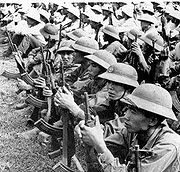
- Ability to learn and adapt. Against both the US and ARVN the VC/NVA demonstrated an ability to adapt on the battlefield. They learned from their mistakes and adopted tactics and measures to reduce losses. These ranged from deep tunnel systems, "hugging" techniques in infantry battles, widespread random mining, fast-moving sapper assaults, treetop fighting positions to foil US helicopters, deployment of new Soviet supplied technology like man-portable missiles, to simple avoidance of battle without overwhelming numerical superiority. The keen study of their own strengths and weaknesses through "criticism and self-criticism," and the systematic distribution of "lessons learned" through reports and memoranda was part of this crucial learning ability, demonstrating that the NLF/PAVN were not the poorly armed peasants of popular lore but a well equipped, serious and sophisticated military organization.
- Superior motivation and morale. Seen in terms of determination to achieve final victory in Indochina, Communist motivation and moraleMoraleMorale, also known as esprit de corps when discussing the morale of a group, is an intangible term used to describe the capacity of people to maintain belief in an institution or a goal, or even in oneself and others...
was superior to that of their enemies. For VC/NVA forces the conflict was not simply another costly Cold War episode but a life and death struggle spanning generations. Some northern leaders stressed the predominance of spiritual over material factors, a notion sometimes paid for with dire results and painful lessons under enemy (particularly American) firepower. Nevertheless many argue that over the course of almost two decades, both PAVN leadership and the ordinary PAVN soldier were more determined to achieve final triumph, and more willing to expend lives and treasure towards this end, than their opponents.
See also
- NLF and PAVN strategy, organization and structure
- NLF and PAVN logistics and equipment
- Strategy and tactics of guerrilla warfareStrategy and tactics of guerrilla warfareStrategy and tactics of guerrilla warfare tend to focus around the use of a small, mobile force competing against a large, unwieldy one. The guerrilla focuses on organising in small units, dependent on the support of the local population...
- Weapons of the Vietnam WarWeapons of the Vietnam WarA wide variety of weapons were used by the different armies operating in the Vietnam War. Combatants included:* the army of the Republic of South Viet Nam ;...
- Vietnam WarVietnam WarThe Vietnam War was a Cold War-era military conflict that occurred in Vietnam, Laos, and Cambodia from 1 November 1955 to the fall of Saigon on 30 April 1975. This war followed the First Indochina War and was fought between North Vietnam, supported by its communist allies, and the government of...
- ARVN
- CommunismCommunismCommunism is a social, political and economic ideology that aims at the establishment of a classless, moneyless, revolutionary and stateless socialist society structured upon common ownership of the means of production...
- History of VietnamHistory of VietnamThe history of Vietnam covers a period of more than 2,700 years. By far Vietnam's most important historical international relationship has been with China. Vietnam's prehistory includes a legend about a kingdom known as Van Lang that included what is now China's Guangxi Autonomous Region and...
- Ho Chi Minh TrailHo Chi Minh trailThe Ho Chi Minh trail was a logistical system that ran from the Democratic Republic of Vietnam to the Republic of Vietnam through the neighboring kingdoms of Laos and Cambodia...
- Tet Offensive
- Military Assistance Command, Vietnam Studies and Observations GroupMilitary Assistance Command, Vietnam Studies and Observations GroupMilitary Assistance Command, Vietnam – Studies and Observations Group was a highly classified, multi-service United States special operations unit which conducted covert unconventional warfare operations prior to and during the Vietnam War....
- The United States and the Vietnam War
- Battle of Stalingrad, Hugging Tactics

